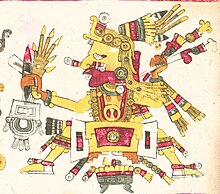托納卡特庫特利

托納卡特庫特利(納瓦特爾語:Tonacatecuhtli)是阿茲特克神話中掌管生育、創造的神袛。他亦是豐收之神,並使地球宜居[1]。大多數殖民時期的手稿表示他與奧梅特奧特爾為同一神[2]。其伴侶為托納卡西瓦特爾。
名稱[編輯]
其名由納瓦特爾語中的tōnacā和tēcuhtli二詞組成[3]。其中「tēcuhtli」意為「主宰者」,而「tōnacā」解釋眾多:部分人將其讀作「tonacā」(無長音o),由「nacatl」(意為「人肉」或者「食物」)與「to」(「我們」的所有格)組成,依此解釋之,其意即為「食物之主」或者「肉體之主」,其中最常見的解釋為「營養之主[2]」。另外,「tōnac」意為「豐收」,故其亦被視為「豐收之主[3]」。
起源與角色[編輯]
托納卡特庫特利是中部美洲宗教中墨西哥中心文化的創造神[2]。據里奧斯手抄本、墨西哥人繪畫歷史、《墨西哥歷史》(Histoyre du Mechique)以及佛羅倫薩手抄本記載,托納卡特庫特利與其伴侶托納卡西瓦特爾(納瓦特爾語:Tonacacihuatl)一同居住在托納卡特庫特利伊錢[4](即第十三重天,人類的靈魂從此地降臨到地球上;其名「Tōnacātēuctli īchān」意為「豐收之主的府邸[5][2][6]」)。托納卡特庫特利亦與生育有關,其形象出現在前哥倫布時期一些有關生殖的藝術作品中。據佛羅倫薩手抄本的記載,阿茲特克的接生人員會在新生兒洗浴過後告訴他們:「你創生於九重天之上的第十三重天(place of duality),由你的父親和母親——奧梅特庫特利(Ōmetēuctli)與奧梅西瓦特爾(Ōmecihuātl)塑造[6]」。
在阿茲特克曆法中,托納卡特庫特利掌管着第一西帕克特利月(1 Cipactli,即第一個月[2])。
在奇馬爾波波卡手抄本中,奧梅特庫特利(Ōmetēuctli)與奧梅西瓦特爾(Ōmecihuātl)常在祭祀中向克特薩爾科瓦特爾(即羽蛇神)禱告[7]。
註釋[編輯]
- ^ Hale.
- ^ 2.0 2.1 2.2 2.3 2.4 Miller & Taube.
- ^ 3.0 3.1 Dictionnaire.
- ^ 又名「奧梅約坎」
- ^ Garibay.
- ^ 6.0 6.1 Sahagún book 6.
- ^ Bierhorst.
參考來源[編輯]
- Bierhorst, John. History and mythology of the Aztecs: the Codex Chimalpopoca. Tucson, AZ: University of Arizona Press. 1992. ISBN 978-0-8165-1886-9.
- Hale, Susan. Mexico. The Story of the Nations 27. London: T. Fisher Unwin. 1891.
- Garibay Kintana, Ángel Ma. (編). Teogonía e historia de los mexicanos: tres opúsculos del siglo xvi. Mexico City: Editorial Porrúa. 1965. ISBN 9789684323124.
- Miller, Mary; Taube, Karl (編). An Illustrated Dictionary of the Gods and Symbols of Ancient Mexico and the Maya. London: Thames & Hudson. 1993. ISBN 0500279284.
- Sahagún, Bernadino. Florentine Codex Book 6: Rhetoric and Moral Philosophy. 由Dibble, Charles E.; Anderson, Arthur J. O.翻譯. Salt Lake City: University of Utah Press. 2012. ISBN 978-1607811619.
- Wimmer, Alexis. Dictionnaire de la langue nahuatl classique (online version, incorporating reproductions from Dictionnaire de la langue nahuatl ou mexicaine [1885], by Rémi Siméon). 2006 [2016-04-05]. (原始內容存檔於2012-12-30).
| ||||||||||||||||||||||||||||||||||||||||||||||||||||||||

